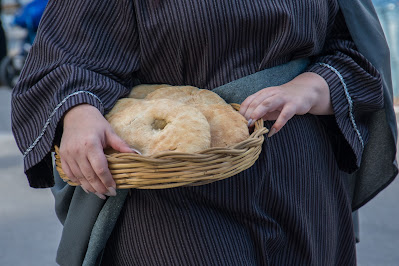In December, I taught an adult forum class at my church, Grace Episcopal Cathedral in Topeka, Kansas, on three essential foods of the first-century Mediterranean diet and how they tie into the holidays. The focus of week one was bread.
Do you still eat bread? I’ll be brave and admit I love it! Especially homemade, warm, and slathered with butter. Mmmm… But I know that bread is on many people’s do-not-consume list, with the low-carb craze still going strong.
Did you know bread was a dietary mainstay during the time of Jesus? It was the most essential component of the first-century Mediterranean diet, made every day and served every meal.
One person was assigned to bake the bread, usually a female family member or a slave in wealthy families. The bread baker would awaken well before everyone else. Her schedule went something like this:
1. Light the fire in the bread oven.2. Grind the wheat into flour. It would take three hours of grinding to make enough flour for bread for five to six people.
3. Make the dough with a bit of dough saved from the day before for leavening, much like we do today with sourdough bread.
4. Sweep out the coals from the oven, which at this point would be about 800 degrees.
5. Bake the bread, saving some of the dough for the next day.
Bread in that era was indeed the staff of life. Sometimes it was all the poor had to eat. As long as you had bread, you would be okay, which may be why the line in the Lord’s Prayer of “give us this day our daily bread” had such significance. When Jesus said, “I am the bread of life,” it was a powerful message to those listening.
I used the book The Food and Feasts of Jesus by Douglas E. Neel and Joel A. Pugh for part of my research, and it includes a wonderful multigrain bread recipe. Instead of adding many different grains, the recipe uses Bob’s Red Mill’s 10 Grain Cereal. I ordered a package online, but you can often find it in natural food stores and some grocery stores.
This bread was a big hit in my household, and the students from my class who made it gave it rave reviews. It’s an easy recipe since a mixer does most of the work. I enjoyed slices of this grainy bread with soup, for sandwiches, and toasted for breakfast.
Makes 4 small round loaves
1 tablespoon active dry yeast
1 1/2 cup warm water (approx. 110 degrees)
6 cups all-purpose flour
1 cup Bob’s Red Mill 10 Grain Cereal
1 tablespoon salt
2 tablespoons unsalted butter, soft or melted
2 tablespoons olive oil
1 1/2 tablespoons honey
1 cup whole milk
In the bowl of a mixer, place the yeast and warm water. Let stand for 15 minutes so activate the yeast. Then add the remaining ingredients.
Mix with a dough hook on low-medium speed for 5 minutes. Let the dough rest in the bowl for 15 minutes, and then mix again for another 5 minutes. The dough should be slightly sticky and springy. Add flour by the tablespoon if too wet, and water by the tablespoon is too dry.
Place the dough in an oiled bowl, turning it to coat the top with oil. Cover with a towel and set aside to rise until double in size, 1 to 1 1/2 hours.
Once the dough has risen, turn it out onto a floured surface and punch down. Knead for about 1 minute, then divide the dough into 4 pieces. Shape into flat, round loaves about 6 to 8 inches in diameter and about 1 to 1 1/2 inches thick in the middle. Place the loaves onto baking sheets lined with parchment paper or lightly coated with non-stick cooking spray. Cover with floured towels and let rise for 1 hour. After 40 minutes, preheat the oven to 400 degrees.
Bake for 20 to 25 minutes, until the loaves are browned and sound hollow when tapped on the bottom. (You can also use an instant-read thermometer to check for doneness. The center of the bread should be 190 degrees F.) Place them on racks and allow them to cool for at least 2 hours before slicing.






